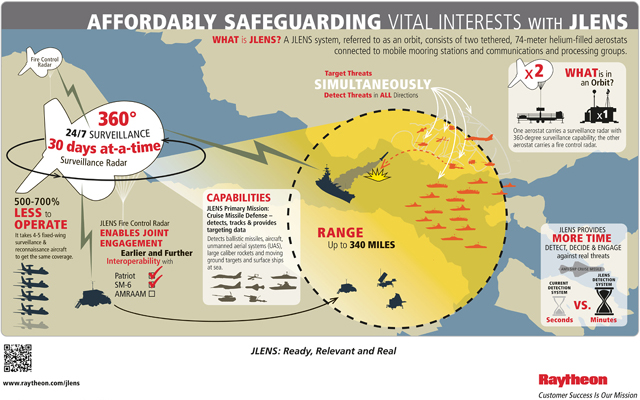The US Army reported yesterday that they completed Early User Testing (EUT) of the Raytheon’s JLENS (Joint Land Attack Cruise Missile Defense Elevated Netted Sensor System), an integrated surveillance and fire-control radar on two tethered, 74-meter aerostats (or blimps). During the six-week-long EUT, soldiers tested JLENS' ability to operate in a number of complex scenarios that duplicated an operational environment in addition to JLENS' endurance by operating the system continually for 20 days (designed to be deployed for up to 30 days). Back in February the military used it to track four ballistic missile targets and last year in separate tests, the military demonstrated JLENS’ ability to defeat cruise missiles by integrating with the Patriot and Standard Missile 6 defensive systems. The military also used the system to track a simulated “swarming-boat” attack.
 Raytheon describes JLENS as an affordable elevated, persistent over-the-horizon sensor system uses a powerful integrated radar system to detect, track and target a variety of threats. This capability better enables commanders to defend against threats including hostile cruise missiles, low-flying manned and unmanned aircraft, tactical ballistic missiles, large caliber rockets, and moving surface vehicles such as boats, SCUD-launchers, automobiles, and tanks.
Raytheon describes JLENS as an affordable elevated, persistent over-the-horizon sensor system uses a powerful integrated radar system to detect, track and target a variety of threats. This capability better enables commanders to defend against threats including hostile cruise missiles, low-flying manned and unmanned aircraft, tactical ballistic missiles, large caliber rockets, and moving surface vehicles such as boats, SCUD-launchers, automobiles, and tanks.
It consists of two tethered, 74-meter helium-filled aerostats connected to mobile mooring stations and a communications and processing groups. The aerostats fly as high as 10,000 feet above sea level and can remain aloft and operational for up to 30 days. One aerostat carries a surveillance radar with 360-degree surveillance capability; the other aerostat carries a fire control radar. Below is a graphic showing the system and its features.

Raytheon says JLENS is affordable because depending on the kind of aircraft used, a fixed-wing surveillance aircraft is 500-700% more expensive to operate than a JLENS during that same time period because of manpower, maintenance and fuel costs. Also, a JLENS orbit uses less than 50% of the manpower it requires to fly a fixed wing aircraft. (That’s not counting the ground-support personnel required to launch a sortie). Who would have thought that a new state-of-the-art system would be using blimps. Below is a video about JLENS.

